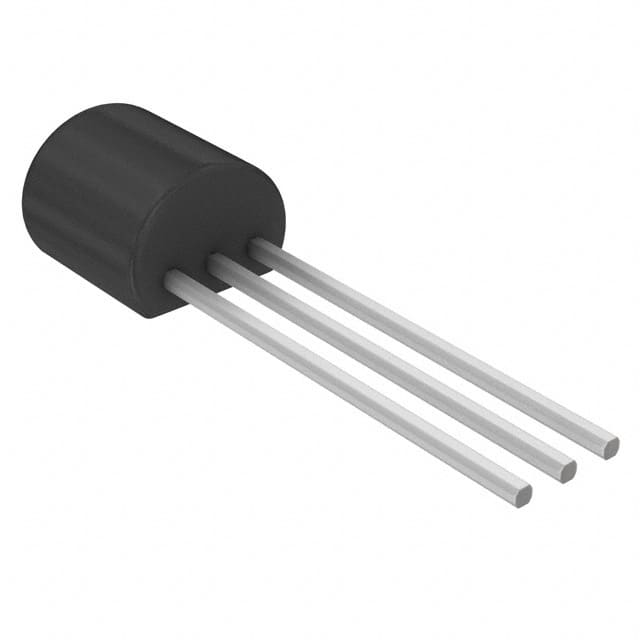Xem thông số kỹ thuật để biết chi tiết sản phẩm.

2N4401 Transistor
Product Overview
The 2N4401 is a general-purpose NPN bipolar junction transistor (BJT) commonly used in electronic circuits for amplification and switching purposes. It falls under the category of discrete semiconductor devices and is widely utilized in various applications due to its versatile characteristics.
Basic Information Overview
- Category: Discrete Semiconductor Device
- Use: Amplification and Switching
- Characteristics: High current gain, low noise, and low power dissipation
- Package: TO-92
- Essence: NPN Bipolar Junction Transistor
- Packaging/Quantity: Typically available in reels or tubes containing multiple units
Specifications
The 2N4401 transistor features the following specifications: - Maximum Collector-Emitter Voltage: 40V - Maximum Collector-Base Voltage: 60V - Maximum Emitter-Base Voltage: 6V - Continuous Collector Current: 600mA - Power Dissipation: 625mW
Detailed Pin Configuration
The 2N4401 transistor has three pins: 1. Emitter (E): Connected to the N-type material 2. Base (B): Controls the transistor's conductivity 3. Collector (C): Collects the majority charge carriers
Functional Features
The key functional features of the 2N4401 include: - High current gain - Low noise - Low power dissipation - Fast switching speed
Advantages and Disadvantages
Advantages
- Versatile application range
- High current gain
- Low power dissipation
Disadvantages
- Limited maximum collector current
- Moderate frequency response
Working Principles
The 2N4401 operates based on the principles of bipolar junction transistors. When a small current flows into the base terminal, it controls a much larger current between the collector and emitter terminals, allowing for amplification and switching functions.
Detailed Application Field Plans
The 2N4401 transistor finds extensive use in various electronic applications, including: - Audio amplifiers - Signal amplification circuits - Switching circuits - Oscillator circuits - Voltage regulators
Detailed and Complete Alternative Models
Some alternative models to the 2N4401 transistor include: - BC547 - 2N3904 - 2N2222 - BC548
In conclusion, the 2N4401 transistor is a versatile and widely-used component in electronic circuits, offering high current gain and low power dissipation. Its applications span across various fields, making it an essential part of many electronic designs.
[Word Count: 345]
Liệt kê 10 câu hỏi và câu trả lời thường gặp liên quan đến ứng dụng 2N4401 trong giải pháp kỹ thuật
Sure, here are 10 common questions and answers related to the application of 2N4401 transistors in technical solutions:
What is a 2N4401 transistor?
- The 2N4401 is a general-purpose NPN bipolar junction transistor commonly used for amplification and switching applications.
What are the typical applications of the 2N4401 transistor?
- The 2N4401 transistor is commonly used in audio amplifiers, signal amplification circuits, and as a switch in electronic circuits.
What are the key electrical characteristics of the 2N4401 transistor?
- The 2N4401 has a maximum collector current (IC) of 600mA, a maximum collector-base voltage (VCBO) of 60V, and a maximum power dissipation (Pd) of 625mW.
How do I identify the pinout of a 2N4401 transistor?
- The pinout of the 2N4401 transistor is typically Emitter-Base-Collector (EBC), with the flat side facing towards you and the pins down, the left pin is the emitter, the middle pin is the base, and the right pin is the collector.
What are the typical operating conditions for the 2N4401 transistor?
- The 2N4401 transistor is typically operated within a temperature range of -55°C to 150°C and at a maximum voltage and current specified in its datasheet.
How do I calculate the base resistor for driving a 2N4401 transistor in a specific circuit?
- The base resistor (RB) can be calculated using Ohm's law and the base current (IB) required for the desired collector current (IC) using the formula RB = (Vcc - Vbe) / IB.
Can the 2N4401 be used for high-frequency applications?
- While the 2N4401 can be used for moderate frequency applications, it may not be suitable for very high-frequency applications due to its transition frequency limitations.
What are some common alternatives to the 2N4401 transistor?
- Common alternatives to the 2N4401 include the 2N2222, BC547, and BC548 transistors, which have similar characteristics and pinouts.
How do I test a 2N4401 transistor to check if it's functioning properly?
- You can use a multimeter to check the continuity between the base, emitter, and collector terminals, and also measure the hFE (DC current gain) to ensure it falls within the specified range.
Where can I find the datasheet for the 2N4401 transistor?
- The datasheet for the 2N4401 transistor can be found on various semiconductor manufacturer websites or distributor platforms, providing detailed specifications and application information.
I hope these questions and answers are helpful for your technical solutions involving the 2N4401 transistor! Let me know if you need further assistance.

